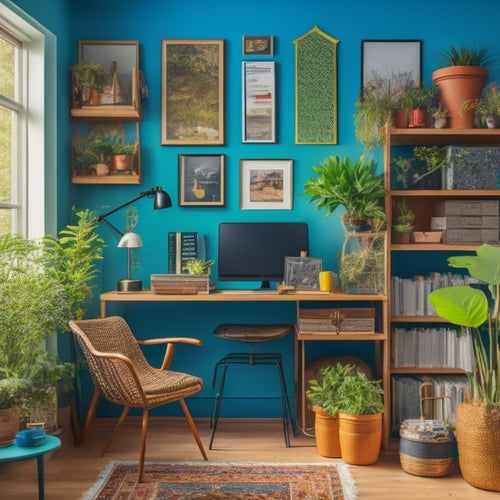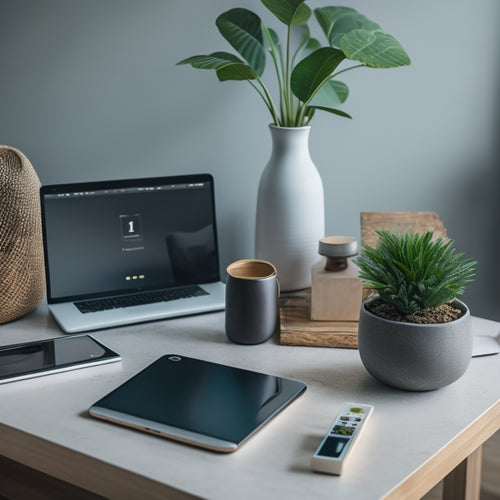
Innovative Classroom Setup Enhances Student Engagement
Share
By designing my classroom setup with intention, I create an environment that sparks engagement and motivation in my students. Interactive learning spaces, relaxation areas, and creative zones help students take ownership of their learning. A peg board station even enhances problem-solving skills! What's more, this setup lays the groundwork for vocational readiness, independence, and confidence. I've found that empowering students with personalized timesheets and task prioritization prepares them for success beyond the classroom. Now, I'm enthusiastic to explore how to further refine my approach to maximize student engagement and achievement.
Key Takeaways
• Deliberate classroom setup fosters engagement and motivation by promoting student ownership and relaxation.
• Interactive learning spaces, such as peg board stations, enhance problem-solving skills and boost enthusiasm for learning.
• Personalized timesheets and task prioritization empower students to take ownership of their learning, promoting independence and skills development.
• Vocational training in action, through hands-on real-world scenarios and simulations, prepares students for future success.
• Effective teaching strategies, including morning routines and differentiated instruction, establish structure and cater to diverse learning needs.
Designing for Engagement
By deliberately designing a classroom setup that incorporates functional areas, teachers can foster an environment that promotes student engagement and motivation.
I've found that creating interactive learning spaces encourages students to take ownership of their learning. For instance, a dedicated relaxation area with sensory tools helps students calm down and refocus.
Meanwhile, a peg board activity station allows students to engage in vocational sorting tasks, developing their problem-solving skills. By incorporating creative spaces like these, I've seen students become more enthusiastic about learning.
It's not just about aesthetics; it's about creating an environment that sparks curiosity and inspires exploration. By doing so, I've witnessed a significant increase in student participation and motivation, leading to a more engaging and effective learning experience.
Fostering Independence and Skills
Every student in my classroom has a personalized timesheet that empowers them to take ownership of their daily tasks, promoting independence and a strong work ethic. This setup allows them to prioritize tasks, manage their time, and develop a sense of responsibility. As they complete tasks, they acquire essential skills that prepare them for vocational readiness.
I've noticed a significant improvement in their ability to work independently, making them more confident and self-sufficient. By fostering independence and skills, I'm setting them up for success beyond the classroom. By providing opportunities for skill acquisition, I'm helping them develop the skills they need to thrive in their future careers.
Vocational Training in Action
As my students develop independence and skills, I'm committed to providing them with hands-on vocational training that prepares them for real-world scenarios, and my classroom setup is designed to facilitate this goal.
To achieve this, I've created a dedicated desk area optimized for practical use and student engagement. This space allows students to participate in real-world simulations, such as kitchen setup for learning life skills with visual aids, and clock exercises for teaching time-telling skills in vocational tasks.
Effective Teaching Strategies
I incorporate a morning routine into my daily lesson plans to establish a sense of structure and responsibility among my students, setting them up for success throughout the day. This routine allows me to implement effective teaching strategies that cater to diverse learning needs.
To achieve this, I employ differentiated instruction through adapted resources, visual aids, and interactive learning activities. For instance:
- I use board games to promote communication and social skills.
- I provide options for students to make decisions in their learning.
- I incorporate vocational training tasks that align with their interests.
- I utilize clocks to teach time-telling skills in a practical and engaging way.
Community and Feedback
Feedback from colleagues and readers has been overwhelmingly positive, with many expressing interest in adapting these innovative classroom setup ideas to enhance their own teaching practices.
It's heartening to see community involvement and reader responses that demonstrate a genuine interest in improving student engagement.
The feedback insights have been invaluable, with many requesting more information on specific topics and sharing their own experiences.
I've been thrilled to share resource links and curriculum ideas, and it's wonderful to see educators coming together to share knowledge and best practices.
Through this exchange, I hope to continue inspiring and guiding new teachers, fostering a spirit of collaboration and community that benefits our students and the education sector as a whole.
Frequently Asked Questions
How Do You Accommodate Students With Diverse Learning Needs in the Classroom?
I accommodate students with diverse learning needs by incorporating individualized accommodations and inclusive teaching strategies, ensuring each student receives tailored support, fostering a thorough and adaptive learning environment that caters to their unique requirements.
What Is the Ideal Student-To-Teacher Ratio for Optimal Learning?
I believe an ideal student-to-teacher ratio is 3:1 to 5:1, allowing for personalized attention, efficient classroom dynamics, and best student progress, while also enabling teachers to implement effective instructional strategies that drive positive learning outcomes.
Can You Share Tips for Creating a Calming Atmosphere in the Relaxation Area?
When creating a calming atmosphere, I prioritize mood lighting by using dimmable lamps and soft seating options like bean bags or pillows to promote relaxation and reduce anxiety, allowing students to unwind and recharge.
How Often Do You Update and Change the Bulletin Board Activities?
"As I envision a dynamic learning space, I update bulletin board activities bi-weekly, incorporating creative displays and student involvement to foster interactive learning, utilizing visual aids that spark curiosity and engagement."
Are There Any Specific Strategies for Teaching Time-Telling Skills to Students With Disabilities?
When teaching time-telling skills to students with disabilities, I use visual aids like clocks with large numbers and hands-on activities like matching clock faces to digital times.
Related Posts
-

3 Best Online Courses for Home Organization Skills
You're just a few clicks away from a clutter-free home and a more efficient daily routine. Three online courses can h...
-

Top Digital Tools for Home Decor Organization
You're looking to take your home decor organization to the next level with the right digital tools. From cloud storag...

